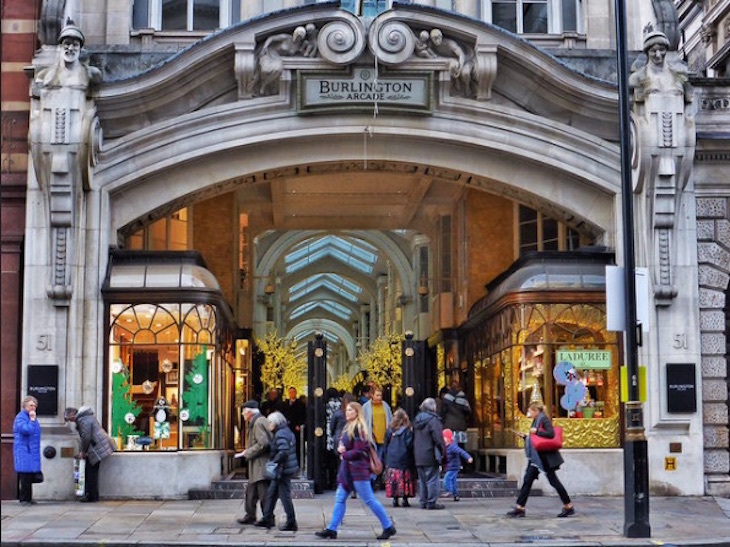You know it for the glamour of The Ritz, the culture of the Royal Academy and the shopping opportunities of Fortnum & Mason... now take a look at Piccadilly in a different light:

1. What is a piccadilly?
The street is thought to be named after Robert Baker, a tailor who bought land here around 1611, and set up a business, selling decorative collars called piccadills. He built himself a home in the area, Piccadilly House.
Prior to being called Piccadilly, it was known as Portugal Street, named for Catherine of Braganza, Charles II's Portuguese wife. When exactly it was renamed as Piccadilly is unknown — both names existed simultaneously until around the 1740s.
2. Where Roald Dahl got his chocolate

Just off Piccadilly, on Old Bond Street, is London's oldest chocolate shop, Charbonnel et Walker. But chocolate lovers should also make a pilgrimage to another nearby treasure trove: Prestat, in Princes Arcade. More than a century old, it's claimed that Roald Dahl was a customer here. Could this be where he got the inspiration for a certain book?
3. London's oldest bookshop

Piccadilly has London's oldest bookshop; Hatchard's was established by publisher John Hatchard in 1791 at 187 Piccadilly. Today, Hatchard's has three royal warrants. Fancy.
Piccadilly is also home to London's largest bookshop, Waterstones, and has seen several other bookshops come and go over the centuries.
4. The Egyptian Hall

If you'd been strolling down Piccadilly in the 1820s, one building in particular would have caught your eye. Completed in 1812, the Egyptian Hall housed a museum of natural history and art, including items brought back by Captain Cook on his far flung voyages.
The exterior of the building was designed to resemble an Egyptian temple, embellished with hieroglyphics and statues of Isis and Osiris, gods of Egyptian mythology. The museum was then at number 22 Piccadilly, which is now closer to 170-173 Piccadilly (roughly opposite the Burlington Arcade and Old Bond Street). It only operated as a museum for seven years, after which it was sold off and used as an exhibition hall. Sadly, it was demolished in 1905. A similarly designed building still exists in Hertford.
5. A Wren design

On the south side of the street, between Waterstones and Fortnum & Mason, is St James's Church Piccadilly. It's set back from the pavement a little, and often hidden behind a market. But next time you go past, make sure you take a look — it was designed by Sir Christopher Wren.
It's said to be similar in design to three of his other churches; St Anne's Soho, St Andrew's by the Wardrobe, and St. Andrew's Holborn.
The idea for building a church here was first discussed in the 1660s. At the time, the area fell under the parish of St Martin-in- the-Fields in Trafalgar Square, but residents wanted their own parish.
6. The Fortnum & Mason clock
If you've ever been walking along Piccadilly at the right time, you may have noticed the following palava:
The clock was installed on the shopfront in 1964, and contains bells cast at Whitechapel Bell Foundry. Every 15 minutes, the bells are played, and once an hour, the figures of Mr Fortnum and Mr Mason appear, and bow to each other.
Fortnum also has beehives on the rooftop. Read more secrets of Fortnum & Mason.
7. Oyster shells

Piccadilly and nearby Mayfair are home to several covered shopping arcades, but Burlington Arcade on Piccadilly claims to be London's oldest. It's said that it was built at the order and expense of Lord George Cavendish in 1819. He lived in the neighbouring Burlington House (now home to the Royal Academy) and wanted it built to stop passers-by throwing rubbish — particularly oyster shells — onto his property.
Hancocks Jewellers in the arcade was responsible for designing the Victoria Cross medal in 1856 and still exists to this day.
8. The first Hard Rock Cafe
Hard Rock Cafe — accompanying t-shirts and all — is everywhere from here to Kathmandu. But the London Piccadilly branch was the original. It opened in its current site at the junction of Piccadilly and Old Park Lane in 1971. The others are merely cover versions.
See also: 11 secrets of Piccadilly Circus




